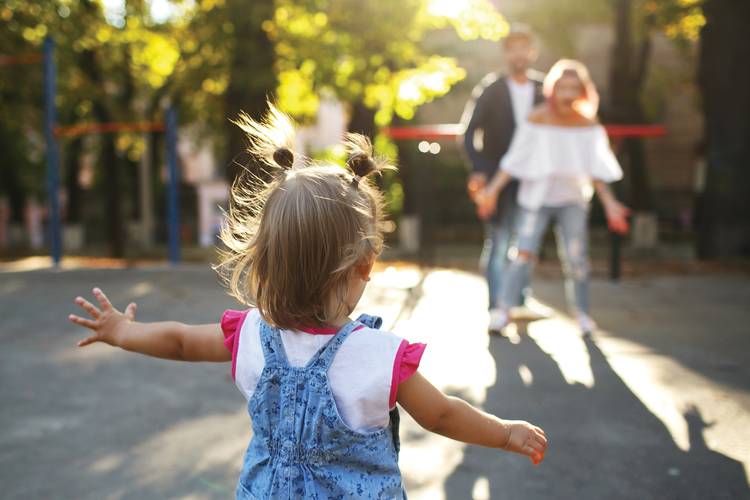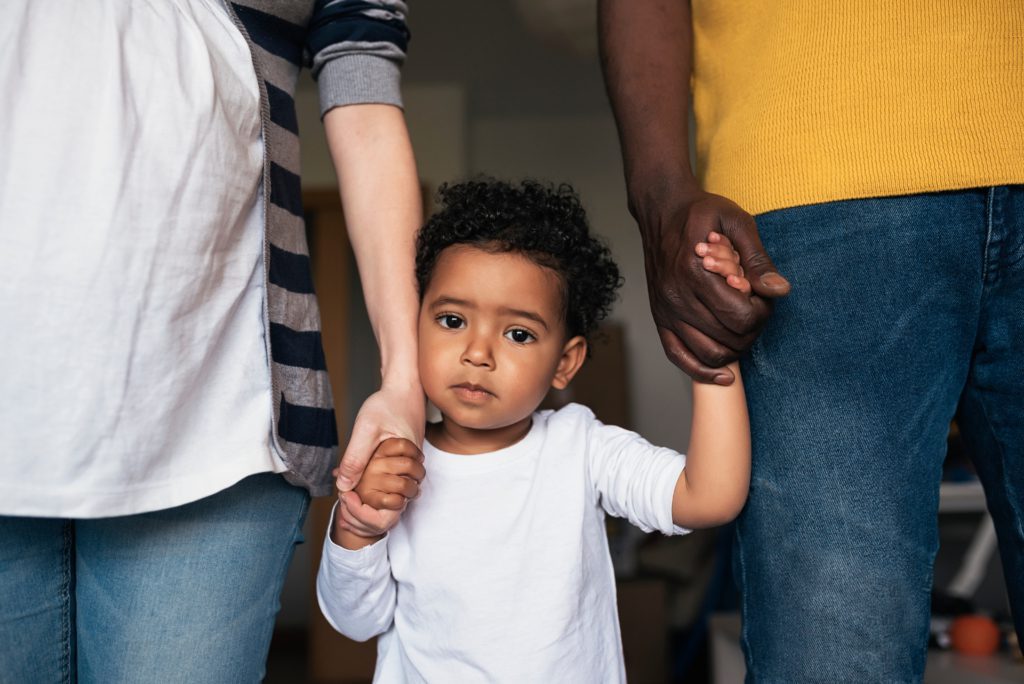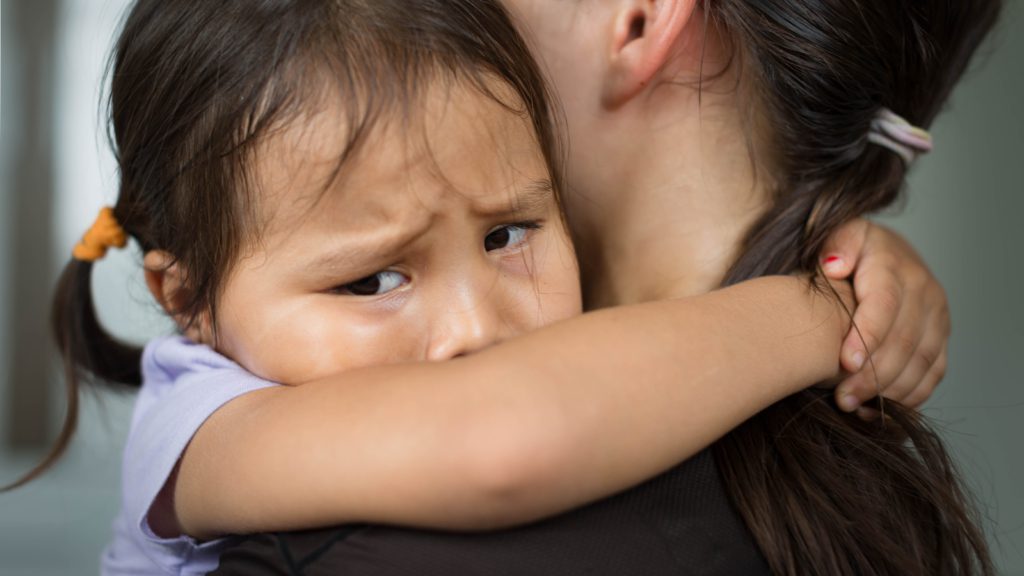Enjoying this resource? Donate to support our library of resources for parents, professionals and policymakers.
Home/Resources/Infant and Early Childhood Mental Health/Divorce With an Under-3 in the House: What You Need to Know
Divorce With an Under-3 in the House: What You Need to Know
Divorce happens. And it affects children even when they’re too little to talk about it. Here’s how to make a difficult transition easier for babies, toddlers, and preschoolers affected by divorce.

Divorce With Young Children: What They Need
Most of all, young children need to know that their people will be there for them, no matter what. Babies as young as 3 months old are affected by parents’ emotions. So, if parents are fighting, or feeling anxious or sad, their young child knows that something’s not right in his world.
Although divorce can be a healthy decision for families, young children don’t have any perspective for making sense of this major change. It is natural and expected that they will feel grief and loss.
What to Say: Explaining Separation and Divorce to Young Children
Parents often search for just the right words to explain separation and divorce in a way that will provide comfort to children. Explanations won’t mean anything to children younger than 18 months old. Children this age will benefit most from physical soothing and comfort (hugs, cuddles, and kisses). Little ones need parents to supply words for the feelings they can’t yet express: You’re upset that Dad’s not here. You will see him tomorrow. I know it’s hard. I love you and I’m here for you. Video-chatting and showing children pictures or videos of their other parent can help with the separation.
Beginning at about 18–24 months, parents can use simple, age-appropriate language to explain.
What divorce means:
You might say: Mommy and Daddy have decided to live in different houses. Mommy and Daddy still love you very much. We will always love you and take very good care of you.
When a parent moves out:
You might say: Tomorrow Mommy will be leaving our house and moving to another house. You will stay here with me some days and stay with Mommy on other days. It can be very helpful for the parent who is moving out to have a place to live already set up before telling the child about the separation. Seeing where mom or dad will be living and that there is a place there for the child—a place to sleep, some toys, etc.—can relieve a lot of worry.
Going from one home to the other:
You might say (even to a baby): You are going to Daddy’s house today. You will bring your clothes and your teddy bear. You will have dinner with Daddy. Then you will sleep at his house. Then I will pick you up in the morning after you wake up and get dressed.
Addressing hopes for getting back together:
It is common for preschoolers to express a desire or hope that their parents will get back together, especially when a couple is co-parenting well. In this situation, it can be difficult for preschoolers to understand why they can’t live in one house again. Parents may need to explain on an on-going basis: I know you really want us to all live together again. But that is not going to happen. Mommy and Mama both love you very much and will continue to work together to be great parents to you. But we have chosen to live separately; we won’t be married anymore.
Addressing worries about being abandoned:
Young children may also share (or show) worries about being abandoned or be concerned that they may themselves “get divorced” from a parent. Parents can reassure children with clear and concrete responses: We will always love you and take care of you. We will never leave you. But we will not live in the same house again.
What to Expect in Divorce with Young Children
Children may experience changes in behavior in the year following a divorce. They may be happy and engaged during some parts of the day, and angry, depressed, or withdrawn during others. It can be easy to overlook children’s sadness when parents are struggling to manage their own difficult emotions.
Babies and toddlers don’t have the words to express their feelings. They may show their distress and confusion in other ways. For example, they may:
- cry more, or be irritable and fussy
- be fearful
- get upset when separated from a person they love
- have stomachaches or changes in bowel habits
- hit or bite
- return to more baby-like behaviors, like night-waking or toileting accidents
- become overactive
- show aggression
- withdraw
Preschoolers have a better understanding of cause and effect. Mom and Dad got divorced, and Dad doesn’t live here anymore. But they don’t understand adult relationships or why people get divorced. They may think they are the cause of the divorce, or that they can do something to make things better. Preschoolers may show the behavioral changes described above, plus a few that are more typical of children their age. For example, they may:
- have nightmares or changes in sleep habits
- complain of headaches and stomachaches
- use “magical thinking” and believe they can make fantasies come true (such as telling a parent the other is coming to visit, even when no such plan exists)
What to Do (and Not Do)
- Let your child be a child. Avoid sharing upsetting details about your ex-partner’s behavior or legal actions or talking badly about them in front of your young child. Talking this way places children in the uncomfortable role of choosing sides, which is impossible—as they love you both.
- Work to maintain effective communication with your co-parent about parenting issues. For example, if a child is having difficulty sleeping, it’s helpful if parents work together to figure out what might be going on and what they can do—jointly—to address the problem.
- Establish consistent daily routines and age-appropriate limits. These help a child feel safe when their world is changing in huge ways. It’s ideal for there to be similar routines and limits in both homes. If your co-parent chooses not to provide this structure, continue to do so (as best you can) at your own house. By maintaining these familiar routines, a child will always know home is a predictable place.
- Encourage your child to talk about and express his feelings, such as anger, sadness, grief, relief, surprise, and betrayal. Help a child put names to these complex emotions and offer age-appropriate, acceptable ways to express them—for example: ripping newspaper, yelling outside, punching a pillow, cuddling with you—or some other approach that works for your family.
- Divorce can be an intensely emotional experience for the whole family—and that includes you. Seeking counseling and/or a good friend to talk to is an important form of self-care. Also helpful: getting enough sleep, eating well, and trying to maintain some of the activities that make you happy. When you take care of yourself, it’s easier to provide that same support and patience to a child.)
Tips for Shared Custody Arrangements—Making the Switch

It’s not unusual for young children to have difficulty making the transition from one parent’s home to the other. It’s often the switch itself, rather than the destination, that is stressful. Young children who are upset during these transfers often become happy, settled, and content once in the other parent’s home. Here’s what parents can do to make the process easier:
- If at all possible, ensure the transition from one home/parent to the other is a civil, peaceful interaction between the two adults. It can feel scary and overwhelming if a young child has to say goodbye (and hello) in the midst of an intense adult argument or tension even young children pick up on.
- Use a goodbye routine (like kissing the child’s palm so they can “take Daddy’s kiss with them”) to help ease the separation.
- If the child has a special loved object (e.g., blanket, stuffed animal, or toy), allow them to take it from one home to the other.
- Place a photo of each parent in the child’s room in both homes.
- For babies, try to keep the routine and accessories the same from home to home—same sheets, same food, same bottles, for example.
- Consider a video call at a regular time each day for the child to connect with the parent at his “other house.”
- For preschoolers who are developing an understanding of time, create a monthly calendar that shows where they will be each day of the week, one color for one parent and a different color for the other. For younger children, using a visual reminder (like making a paper chain of 5 links, and removing one each day to count down to a weekend with the other parent) is more helpful.
Divorce is a stressful experience for all members of the family, and young children are particularly vulnerable. But they are also resilient. With patience, sensitivity, and support, parents and other loved ones can help children navigate this major life change.

Next Up
Go to Next ResourceSupporting Your Young Child Through Separation or Divorce
By Claire Lerner Divorce isn’t easy for anyone, especially for young children. The most important thing parents can do is take time to manage their own feelings so they can focus on the needs and feelings of their children. When parents are able to collaborate, it helps children feel safe, secure, and loved—even as their family is changing. We read […]



